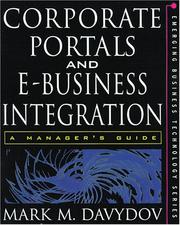| Listing 1 - 10 of 710 | << page >> |
Sort by
|
Book
Year: 2001 Publisher: Washington, District of Columbia : World Bank,
Abstract | Keywords | Export | Availability | Bookmark
 Loading...
Loading...Choose an application
- Reference Manager
- EndNote
- RefWorks (Direct export to RefWorks)
The authors have prepared this paper as a companion to the Trade and Production database, which contains trade, production, and tariff data for 67 industrial and developing countries at the industry level for 1976-99. The sector disaggregation in the database follows the International Standard Industrial Classification (ISIC), with data provided at the three-digit level (28 industries) for all 67 countries and at the four-digit level (81 industries) for 24 of these countries. The production data are from the United Nations Industrial Development Organization's Industrial Statistics Database at the three- and four-digit level of ISIC. They include value added, total output, average wages, capital formation, number of employees, number of female employees, and number of firms. The trade data are from the United Nations Statistics Division's Commodity Trade (Comtrade) database (through the World Bank's World Integrated Trade Solution, or WITS, software) and include imports and exports. Data on mirror exports (reported by trading partners) were obtained using WITS. The trade data are aggregated by region and income group, as defined by the World Bank. A separate data set provides bilateral trade flows (by partner) at the industry level. The data on average tariffs (most favored nation) are from the Trains database maintained by the United Nations Conference on Trade and Development and from the World Trade Organization's Trade Policy Reviews and Integrated Database. The database also provides an input-output table for each country using data from version 4 of the Global Trade Analysis Project (GTAP) database. The database is available on request on CD-ROM in a series of ASCII files and Microsoft Excel worksheets. It is also available on the Web at http://www.worldbank.org./research/trade.
Book
ISBN: 9780754512134 0754512134 Year: 2001 Publisher: London: Butterworths,
Abstract | Keywords | Export | Availability | Bookmark
 Loading...
Loading...Choose an application
- Reference Manager
- EndNote
- RefWorks (Direct export to RefWorks)
Book
ISBN: 2922417255 9782922417258 Year: 2001 Publisher: Montréal: Quentin,
Abstract | Keywords | Export | Availability | Bookmark
 Loading...
Loading...Choose an application
- Reference Manager
- EndNote
- RefWorks (Direct export to RefWorks)
Commerce electronique --- Commerce électronique --- Commerce electronique
Book
Abstract | Keywords | Export | Availability | Bookmark
 Loading...
Loading...Choose an application
- Reference Manager
- EndNote
- RefWorks (Direct export to RefWorks)

ISBN: 0071371796 Year: 2001 Publisher: New York (N.Y.) : McGraw-Hill,
Abstract | Keywords | Export | Availability | Bookmark
 Loading...
Loading...Choose an application
- Reference Manager
- EndNote
- RefWorks (Direct export to RefWorks)

ISBN: 0471494550 Year: 2001 Publisher: Chichester : Wiley,
Abstract | Keywords | Export | Availability | Bookmark
 Loading...
Loading...Choose an application
- Reference Manager
- EndNote
- RefWorks (Direct export to RefWorks)

ISBN: 9780471899419 0471899410 Year: 2001 Publisher: Chichester: Wiley,
Abstract | Keywords | Export | Availability | Bookmark
 Loading...
Loading...Choose an application
- Reference Manager
- EndNote
- RefWorks (Direct export to RefWorks)
Book
Year: 2001 Publisher: Cambridge, Mass. National Bureau of Economic Research
Abstract | Keywords | Export | Availability | Bookmark
 Loading...
Loading...Choose an application
- Reference Manager
- EndNote
- RefWorks (Direct export to RefWorks)
The gravity model has been widely used to infer substantial trade flow effects of institutions such as customs unions and exchange rate mechanisms. McCallum [1995] found that the US-Canada border led to trade between provinces that is a factor 22 (2,200%) times trade between states and provinces, a spectacular puzzle in light of the low formal barriers on this border. We show that the gravity model usually estimated does not correspond to the theory behind it. We solve the 'border puzzle' by applying the theory seriously. We find that national borders reduce trade between the US and Canada by about 44%, while reducing trade among other industrialized countries by about 30%. McCallum's spectacular headline number is the result of a combination of omitted variables bias and the small size of the Canadian economy. Within-Canada trade rises by a factor 6 due to the border. In contrast, within-US trade rises 25%.
Periodical
Year: 2001 Publisher: [Tokyo] Japan External Trade Organization,
Abstract | Keywords | Export | Availability | Bookmark
 Loading...
Loading...Choose an application
- Reference Manager
- EndNote
- RefWorks (Direct export to RefWorks)
Book
Year: 2001 Publisher: Oxford : Oxford University Press,
Abstract | Keywords | Export | Availability | Bookmark
 Loading...
Loading...Choose an application
- Reference Manager
- EndNote
- RefWorks (Direct export to RefWorks)
Regional trading arrangements have become a feature of international trade in the 1990s. 'The Economics of Regional Trading Arrangements' provides a unified analysis of policies which discriminate among trading partners.
Commerce --- Business & Economics --- International Commerce
| Listing 1 - 10 of 710 | << page >> |
Sort by
|

 Search
Search Feedback
Feedback About
About Help
Help News
News